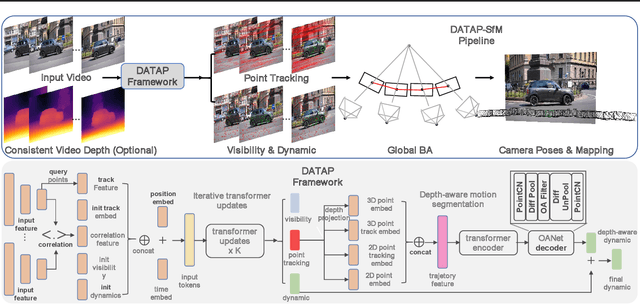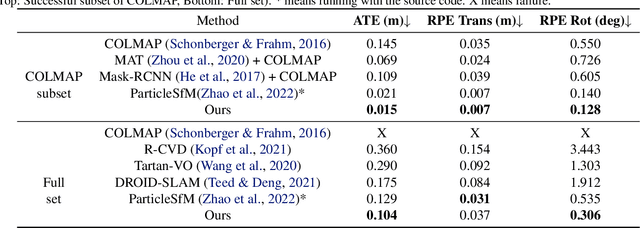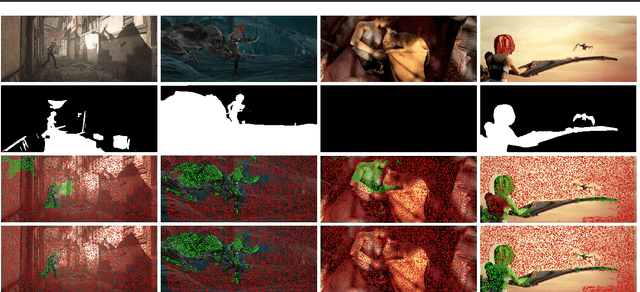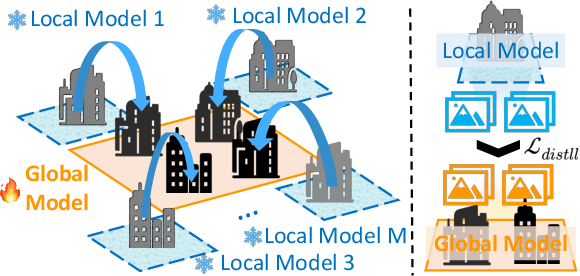Weicai Ye
FullDiT2: Efficient In-Context Conditioning for Video Diffusion Transformers
Jun 05, 2025Abstract:Fine-grained and efficient controllability on video diffusion transformers has raised increasing desires for the applicability. Recently, In-context Conditioning emerged as a powerful paradigm for unified conditional video generation, which enables diverse controls by concatenating varying context conditioning signals with noisy video latents into a long unified token sequence and jointly processing them via full-attention, e.g., FullDiT. Despite their effectiveness, these methods face quadratic computation overhead as task complexity increases, hindering practical deployment. In this paper, we study the efficiency bottleneck neglected in original in-context conditioning video generation framework. We begin with systematic analysis to identify two key sources of the computation inefficiencies: the inherent redundancy within context condition tokens and the computational redundancy in context-latent interactions throughout the diffusion process. Based on these insights, we propose FullDiT2, an efficient in-context conditioning framework for general controllability in both video generation and editing tasks, which innovates from two key perspectives. Firstly, to address the token redundancy, FullDiT2 leverages a dynamic token selection mechanism to adaptively identify important context tokens, reducing the sequence length for unified full-attention. Additionally, a selective context caching mechanism is devised to minimize redundant interactions between condition tokens and video latents. Extensive experiments on six diverse conditional video editing and generation tasks demonstrate that FullDiT2 achieves significant computation reduction and 2-3 times speedup in averaged time cost per diffusion step, with minimal degradation or even higher performance in video generation quality. The project page is at \href{https://fulldit2.github.io/}{https://fulldit2.github.io/}.
Any2Caption:Interpreting Any Condition to Caption for Controllable Video Generation
Mar 31, 2025Abstract:To address the bottleneck of accurate user intent interpretation within the current video generation community, we present Any2Caption, a novel framework for controllable video generation under any condition. The key idea is to decouple various condition interpretation steps from the video synthesis step. By leveraging modern multimodal large language models (MLLMs), Any2Caption interprets diverse inputs--text, images, videos, and specialized cues such as region, motion, and camera poses--into dense, structured captions that offer backbone video generators with better guidance. We also introduce Any2CapIns, a large-scale dataset with 337K instances and 407K conditions for any-condition-to-caption instruction tuning. Comprehensive evaluations demonstrate significant improvements of our system in controllability and video quality across various aspects of existing video generation models. Project Page: https://sqwu.top/Any2Cap/
SketchVideo: Sketch-based Video Generation and Editing
Mar 30, 2025



Abstract:Video generation and editing conditioned on text prompts or images have undergone significant advancements. However, challenges remain in accurately controlling global layout and geometry details solely by texts, and supporting motion control and local modification through images. In this paper, we aim to achieve sketch-based spatial and motion control for video generation and support fine-grained editing of real or synthetic videos. Based on the DiT video generation model, we propose a memory-efficient control structure with sketch control blocks that predict residual features of skipped DiT blocks. Sketches are drawn on one or two keyframes (at arbitrary time points) for easy interaction. To propagate such temporally sparse sketch conditions across all frames, we propose an inter-frame attention mechanism to analyze the relationship between the keyframes and each video frame. For sketch-based video editing, we design an additional video insertion module that maintains consistency between the newly edited content and the original video's spatial feature and dynamic motion. During inference, we use latent fusion for the accurate preservation of unedited regions. Extensive experiments demonstrate that our SketchVideo achieves superior performance in controllable video generation and editing.
FullDiT: Multi-Task Video Generative Foundation Model with Full Attention
Mar 25, 2025Abstract:Current video generative foundation models primarily focus on text-to-video tasks, providing limited control for fine-grained video content creation. Although adapter-based approaches (e.g., ControlNet) enable additional controls with minimal fine-tuning, they encounter challenges when integrating multiple conditions, including: branch conflicts between independently trained adapters, parameter redundancy leading to increased computational cost, and suboptimal performance compared to full fine-tuning. To address these challenges, we introduce FullDiT, a unified foundation model for video generation that seamlessly integrates multiple conditions via unified full-attention mechanisms. By fusing multi-task conditions into a unified sequence representation and leveraging the long-context learning ability of full self-attention to capture condition dynamics, FullDiT reduces parameter overhead, avoids conditions conflict, and shows scalability and emergent ability. We further introduce FullBench for multi-task video generation evaluation. Experiments demonstrate that FullDiT achieves state-of-the-art results, highlighting the efficacy of full-attention in complex multi-task video generation.
CoSurfGS:Collaborative 3D Surface Gaussian Splatting with Distributed Learning for Large Scene Reconstruction
Dec 23, 2024Abstract:3D Gaussian Splatting (3DGS) has demonstrated impressive performance in scene reconstruction. However, most existing GS-based surface reconstruction methods focus on 3D objects or limited scenes. Directly applying these methods to large-scale scene reconstruction will pose challenges such as high memory costs, excessive time consumption, and lack of geometric detail, which makes it difficult to implement in practical applications. To address these issues, we propose a multi-agent collaborative fast 3DGS surface reconstruction framework based on distributed learning for large-scale surface reconstruction. Specifically, we develop local model compression (LMC) and model aggregation schemes (MAS) to achieve high-quality surface representation of large scenes while reducing GPU memory consumption. Extensive experiments on Urban3d, MegaNeRF, and BlendedMVS demonstrate that our proposed method can achieve fast and scalable high-fidelity surface reconstruction and photorealistic rendering. Our project page is available at \url{https://gyy456.github.io/CoSurfGS}.
LLaVA-SLT: Visual Language Tuning for Sign Language Translation
Dec 21, 2024



Abstract:In the realm of Sign Language Translation (SLT), reliance on costly gloss-annotated datasets has posed a significant barrier. Recent advancements in gloss-free SLT methods have shown promise, yet they often largely lag behind gloss-based approaches in terms of translation accuracy. To narrow this performance gap, we introduce LLaVA-SLT, a pioneering Large Multimodal Model (LMM) framework designed to leverage the power of Large Language Models (LLMs) through effectively learned visual language embeddings. Our model is trained through a trilogy. First, we propose linguistic continued pretraining. We scale up the LLM and adapt it to the sign language domain using an extensive corpus dataset, effectively enhancing its textual linguistic knowledge about sign language. Then, we adopt visual contrastive pretraining to align the visual encoder with a large-scale pretrained text encoder. We propose hierarchical visual encoder that learns a robust word-level intermediate representation that is compatible with LLM token embeddings. Finally, we propose visual language tuning. We freeze pretrained models and employ a lightweight trainable MLP connector. It efficiently maps the pretrained visual language embeddings into the LLM token embedding space, enabling downstream SLT task. Our comprehensive experiments demonstrate that LLaVA-SLT outperforms the state-of-the-art methods. By using extra annotation-free data, it even closes to the gloss-based accuracy.
Splatter-360: Generalizable 360$^{\circ}$ Gaussian Splatting for Wide-baseline Panoramic Images
Dec 09, 2024Abstract:Wide-baseline panoramic images are frequently used in applications like VR and simulations to minimize capturing labor costs and storage needs. However, synthesizing novel views from these panoramic images in real time remains a significant challenge, especially due to panoramic imagery's high resolution and inherent distortions. Although existing 3D Gaussian splatting (3DGS) methods can produce photo-realistic views under narrow baselines, they often overfit the training views when dealing with wide-baseline panoramic images due to the difficulty in learning precise geometry from sparse 360$^{\circ}$ views. This paper presents \textit{Splatter-360}, a novel end-to-end generalizable 3DGS framework designed to handle wide-baseline panoramic images. Unlike previous approaches, \textit{Splatter-360} performs multi-view matching directly in the spherical domain by constructing a spherical cost volume through a spherical sweep algorithm, enhancing the network's depth perception and geometry estimation. Additionally, we introduce a 3D-aware bi-projection encoder to mitigate the distortions inherent in panoramic images and integrate cross-view attention to improve feature interactions across multiple viewpoints. This enables robust 3D-aware feature representations and real-time rendering capabilities. Experimental results on the HM3D~\cite{hm3d} and Replica~\cite{replica} demonstrate that \textit{Splatter-360} significantly outperforms state-of-the-art NeRF and 3DGS methods (e.g., PanoGRF, MVSplat, DepthSplat, and HiSplat) in both synthesis quality and generalization performance for wide-baseline panoramic images. Code and trained models are available at \url{https://3d-aigc.github.io/Splatter-360/}.
Unleashing the Potential of Multi-modal Foundation Models and Video Diffusion for 4D Dynamic Physical Scene Simulation
Nov 21, 2024



Abstract:Realistic simulation of dynamic scenes requires accurately capturing diverse material properties and modeling complex object interactions grounded in physical principles. However, existing methods are constrained to basic material types with limited predictable parameters, making them insufficient to represent the complexity of real-world materials. We introduce a novel approach that leverages multi-modal foundation models and video diffusion to achieve enhanced 4D dynamic scene simulation. Our method utilizes multi-modal models to identify material types and initialize material parameters through image queries, while simultaneously inferring 3D Gaussian splats for detailed scene representation. We further refine these material parameters using video diffusion with a differentiable Material Point Method (MPM) and optical flow guidance rather than render loss or Score Distillation Sampling (SDS) loss. This integrated framework enables accurate prediction and realistic simulation of dynamic interactions in real-world scenarios, advancing both accuracy and flexibility in physics-based simulations.
DATAP-SfM: Dynamic-Aware Tracking Any Point for Robust Structure from Motion in the Wild
Nov 20, 2024



Abstract:This paper proposes a concise, elegant, and robust pipeline to estimate smooth camera trajectories and obtain dense point clouds for casual videos in the wild. Traditional frameworks, such as ParticleSfM~\cite{zhao2022particlesfm}, address this problem by sequentially computing the optical flow between adjacent frames to obtain point trajectories. They then remove dynamic trajectories through motion segmentation and perform global bundle adjustment. However, the process of estimating optical flow between two adjacent frames and chaining the matches can introduce cumulative errors. Additionally, motion segmentation combined with single-view depth estimation often faces challenges related to scale ambiguity. To tackle these challenges, we propose a dynamic-aware tracking any point (DATAP) method that leverages consistent video depth and point tracking. Specifically, our DATAP addresses these issues by estimating dense point tracking across the video sequence and predicting the visibility and dynamics of each point. By incorporating the consistent video depth prior, the performance of motion segmentation is enhanced. With the integration of DATAP, it becomes possible to estimate and optimize all camera poses simultaneously by performing global bundle adjustments for point tracking classified as static and visible, rather than relying on incremental camera registration. Extensive experiments on dynamic sequences, e.g., Sintel and TUM RGBD dynamic sequences, and on the wild video, e.g., DAVIS, demonstrate that the proposed method achieves state-of-the-art performance in terms of camera pose estimation even in complex dynamic challenge scenes.
DGTR: Distributed Gaussian Turbo-Reconstruction for Sparse-View Vast Scenes
Nov 20, 2024



Abstract:Novel-view synthesis (NVS) approaches play a critical role in vast scene reconstruction. However, these methods rely heavily on dense image inputs and prolonged training times, making them unsuitable where computational resources are limited. Additionally, few-shot methods often struggle with poor reconstruction quality in vast environments. This paper presents DGTR, a novel distributed framework for efficient Gaussian reconstruction for sparse-view vast scenes. Our approach divides the scene into regions, processed independently by drones with sparse image inputs. Using a feed-forward Gaussian model, we predict high-quality Gaussian primitives, followed by a global alignment algorithm to ensure geometric consistency. Synthetic views and depth priors are incorporated to further enhance training, while a distillation-based model aggregation mechanism enables efficient reconstruction. Our method achieves high-quality large-scale scene reconstruction and novel-view synthesis in significantly reduced training times, outperforming existing approaches in both speed and scalability. We demonstrate the effectiveness of our framework on vast aerial scenes, achieving high-quality results within minutes. Code will released on our [https://3d-aigc.github.io/DGTR].
 Add to Chrome
Add to Chrome Add to Firefox
Add to Firefox Add to Edge
Add to Edge